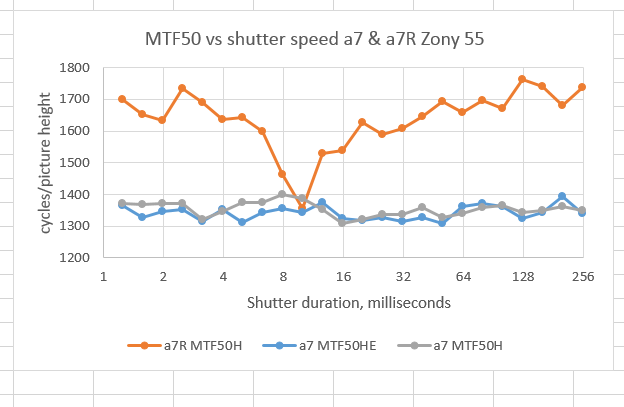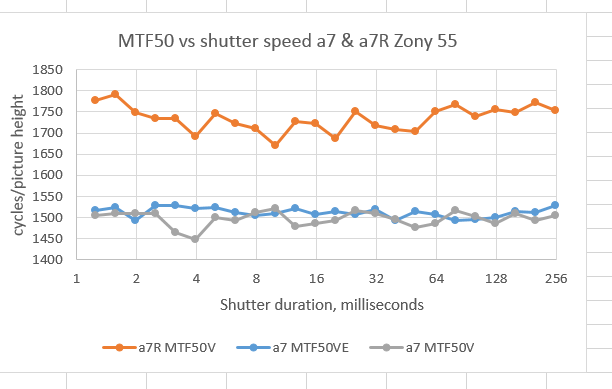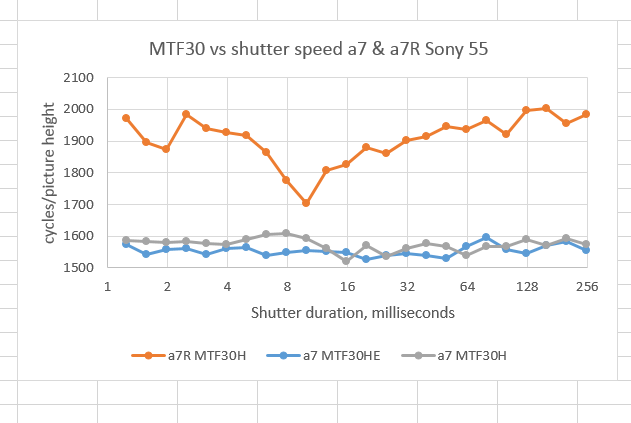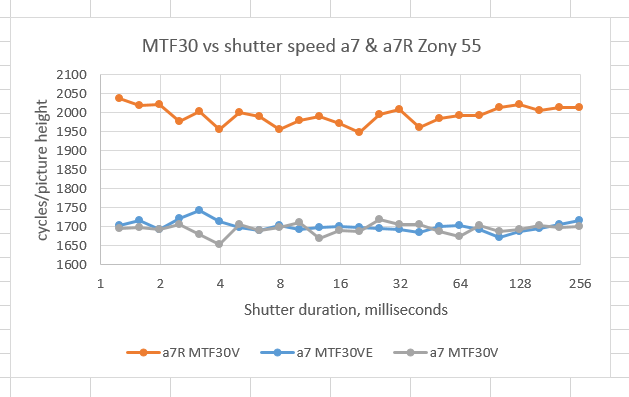A reader asked me to run some tests to see how much the a7 suffered from shutter shock with and without the electronic first curtain shutter. I was intrigued. I decided to start with what should be a pretty easy test, so I used a 55mm lens. Since I haven’t tested the a7R with this lens with my new protocol, I tested both cameras. Thus, we have three sets of results: a7R, a7 with EFCS, and a7 without EFCS.
I mounted a Sony/Zeiss 55mm f/1.8 Sonnar FE (hereafter called the Zony 55) to the camera under test. I mounted a RRS L-plate, clipped it in landscape orientation into an Arca Swiss C1 head which was attached to a set of RRS TVC-44 legs.
I mounted a Heliopan variable ND filter on the lens. I lit an Imatest SFRPlus target with a Fotodiox 5500K variable output LED source. I set the ISO to 400, focused wide open, and set the aperture to f/5.6. Using the ND filter and the light together to control the, and made a series of exposures of durations from 1/800 second through ¼ second at 1/3 stop intervals. With the light on full and shutter speed set to 1/800 at the start, I controlled the number of photons hitting the sensor with the ND filter until I got to 1/60 second, then I left the filter at that setting, and controlled the light level with the Fotodiox control until I got to ¼ second.
I processed the images in Lightroom 5.3 with default settings except for cropping and white balance, then I processed them in Imatest, measuring the MTF30 and MTF50 for both vertical and horizontal edges. I converted the Imatest cycles/pixel data to cycles/picture height, and made plots.
MTF50 for horizontal edges (the a7 curve with the EFCS on is indicated by the E suffix:
You can see that a7R exposures near 10 milliseconds (1/100 second) are affected enough by shutter shock that the vertical resolution drops to that of the a7. Surprisingly, at least to me, is that the a7 is not much affected by its mechanical first curtain shutter.
MTF50 for vertical edges:
There is a small, but noticeable effect of the a7’s mechanical FCS at shutter speeds of around 4 milliseconds (1/250 second). At all times the a7R horizontal resolution (the resolution for vertical edges) is better than the a7’s.
MTF30 for horizontal edges:
This looks a lot like the MTF50 curve, except that the a7R’s shutter shock does not adversely affect image quality enough to bring it down to the level of the a7.
MTF30 for vertical edges:
As in the MTF50 case, the horizontal resolution of the a7R in landscape mode is not much affected by shutter shock with this lens.




> Surprisingly, at least to me, is that the a7 is not much affected by its mechanical first curtain shutter.
indeed… kind of unexpected, may be because of tripod + short (dimensions) lens though (and the story will be totally different with camera in hands)
See the next post.
still does not explain why while A7R (w/ 55mm, body mounted) is noticeably affected by relatively slow moving shutter blade (1/160 x-sync), A7 (w/ 55mm, body mounted) is not with faster moving shutter blade (1/250 x-sync, EFCS OFF)… unless the body material itself makes some difference (plastic front in A7 vs metal front plate in A7R) ?
I think one of the big reasons that the a7R is more affected is that it has higher resolution to start with. Remember, these resolution impairments tend to add up as the square root of the sum of the squares…
Jim
> I think one of the big reasons that the a7R is more affected
but the surprise is exactly that A7 was not affected at all in one particular test (the first graph in your post)… isn’t it illogical ? it is not like 24mp is affected to some lesser degree… it is like it is not affected at all (not talking about the situation when you mount tele lens on tripod with A7 attached to that lens, etc)… the way you mount bodies was the same, so it is either the body itself and/or mechanical-wise the shutter in A7 is just not only faster, but better than in A7R (except that really smallish drop @ 1/250 for horizontal resolution, but not as expected for vertical one)
Am i wrong in seeing that their x sync speeds are the worse?
Any chance of comparing Ricoh GR, DP Quattro in a studio set up against the big boys ( Canon 5diii, Nikon D8xx, PhaseOne)? Say, comparing tonality, vibrations and colour shifts at 400-800asa for a 23 x 34 cm size magazine’s spread.
Thanks again for all that tesing and sharing!
Why you use 55mm ? All I know the shutter vibration usually come with longer lens . It is better to compare with at least 135mm.